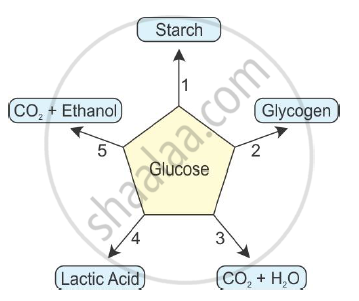Advertisements
Advertisements
प्रश्न
What are the differences between aerobic and anaerobic respiration? Name some organisms that use the anaerobic mode of respiration.
What is the main difference between aerobic respiration and anaerobic respiration? Give one example of each.
उत्तर
| Aerobic respiration | Anaerobic respiration |
| It occurs in the presence of O2. | It occurs in the absence of O2. |
| It involves the exchange of gases between the organism and the outside environment. | Exchange of gases is absent. |
| It occurs in cytoplasm and mitochondria. | It occurs only in cytoplasm. |
| It always releases CO2 and H2O. | End products vary. |
| More energy is released. | Less energy is released. |
| For example, plants and animals (eukaryotes). | For example, yeast, bacteria. |
Some organisms that use the anaerobic mode of respiration are - yeast, bacteria, etc.
APPEARS IN
संबंधित प्रश्न
Given below are the end products of different reactions involving glucose.

Write the reaction number in front of the following:
(i) Anaerobic reaction =
(ii) Reaction in the human muscles =
(iii) Aerobic respiration =
(iv) Reaction in the plant cells =
(v) Reaction in the liver
Carbon dioxide enters into the leaves through tiny pores present on the surface of the leaf called _________.
(a) chlorophyll
(b) chloroplast
(c) stomata
(d) epidermis
The breakdown of pyruvate to give carbon dioxide, water, and energy takes place in ______.
The mountaineers carry oxygen with them because ______.
State whether the following statement is true or false:
during respiration, the plants take CO2 and release O2.
Describe the process of respiration in the following part of a plant:
Stem
Describe the process of respiration in the following part of a plant:
Leaves
From where do the aquatic animals and terrestrial animals obtain oxygen for breathing and respiration?
Name the energy currency in the living organisms. When and where is it produced?
Which of the following is known as the energy currency of the cells in biology?
Which of the following is most likely to have a much higher breathing rate?
When a person breathes in the air, the air enters into his body through an organ A having two holes B in it. The air then passes through the pharynx and larynx and enters into tube C. The tube C divides into two smaller tubes D at its lower end. The two smaller tubes are attached to two respiratory organs E. Each smaller tube divides inside the organs E to form a large number of still smaller tubes called F. The smallest tubes F have air-sacs G at their ends in which gaseous exchange takes place in the body of the person. What are A, B, C, D, E, F, and G?
What happens to the glucose which enters the nephron tubule alongwith the filtrate?
With which human organ system (or human systems) is alveoli associated?
Veins and arteries carry blood. Which of these carry blood back to the heart?
Answer this question.
What are the holes on the sides of the body of insects called?
Tick the most appropriate answer.
The products of respiration are :
Choose the odd one out in the following groups of four items each:
Trachea, Bronchus, Alveolus, Diaphragm
Choose the odd one out in the following groups of four items each:
Ethyl alcohol, Carbon dioxide, Starch, Oxygen
Choose the odd one out in each of the following groups of four items each:
Oxyhaemoglobin, Carbaminohaemoglobin, Hypoxia, Carboxyhaemoglobin
Name the body structure concerned with the given functional activity:
Transports oxygen to the body cells.
Name the body structure concerned with the given functional activity:
Protects the lungs from mechanical injury
Name the body structure concerned with the given functional activity:
Provides actual diffusion of respiratory gases in the lungs.
Which chemical compound inside a cell can be termed "Currency of Energy"?
Given below is an example of certain structure and its special functional activity:
"Kidney and excretion".
Fill in the blanks on a similar pattern.
Alveoli and _____________.
State one function of the following:
Ciliated epithelium lining the respiratory tract
How is the respiratory passage kept free of dust particles?
Differentiate between the following pairs on the basis of the aspect given in the brackets.
Tidal volume and Residual volume (Quantity of air)
Given below is an overall chemical reaction of a certain process:
C6H12O6→LacticAcid+2ATP+Heat energy
Is this reaction applicable to animals or to plants or to both animals and plants?
List the organs of Human respiratory system.
Answer the following question.
A gas is released during photosynthesis. Name the gas and also state the way by which the gas is evolved.
The Figure shown below represents an activity to prove the requirements for photosynthesis. During this activity, two healthy potted plants were kept in the dark for 72 hours. After 72 hours, KOH is kept in the watch glass in setup X and not in setup Y. Both these setups are air tight and have been kept in light for 6 hours. Then, Iodine Test is performed with one leaf from each of the two plants X and Y.

The function of KOH is to absorb ______.
Which is the correct sequence of air passage during inhalation?
How does aerobic respiration differ from anaerobic respiration?
The exchange of gases in the leaves takes place with the help of __________.
On a very cold morning, Boojho and Paheli were talking with each other as they walked down to their school. They observed that the air coming out of their mouth looked like smoke. They were amused and wondered how it happened. Help them find the answer.
List the similarities between aerobic and anaerobic respiration.
